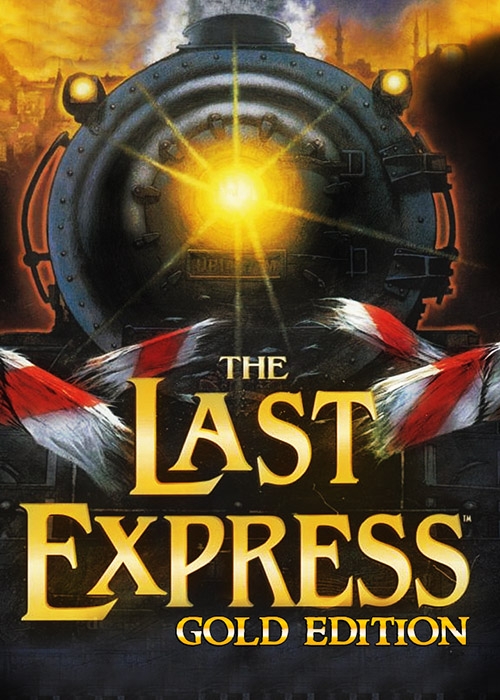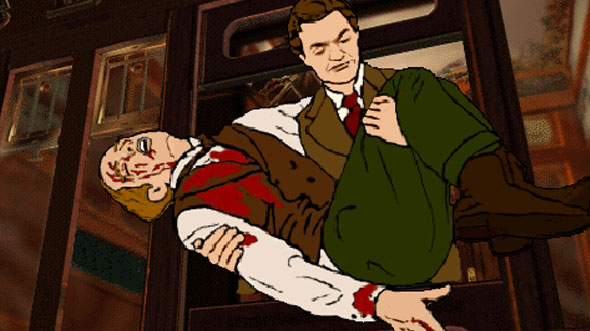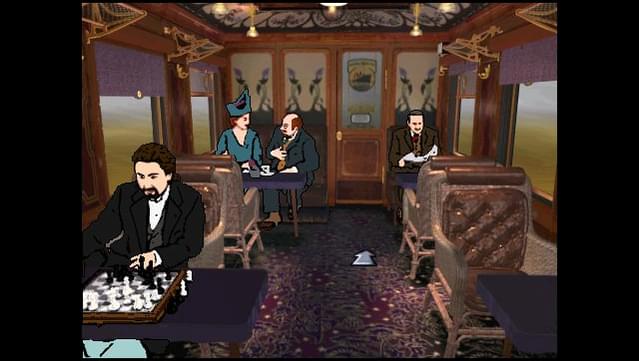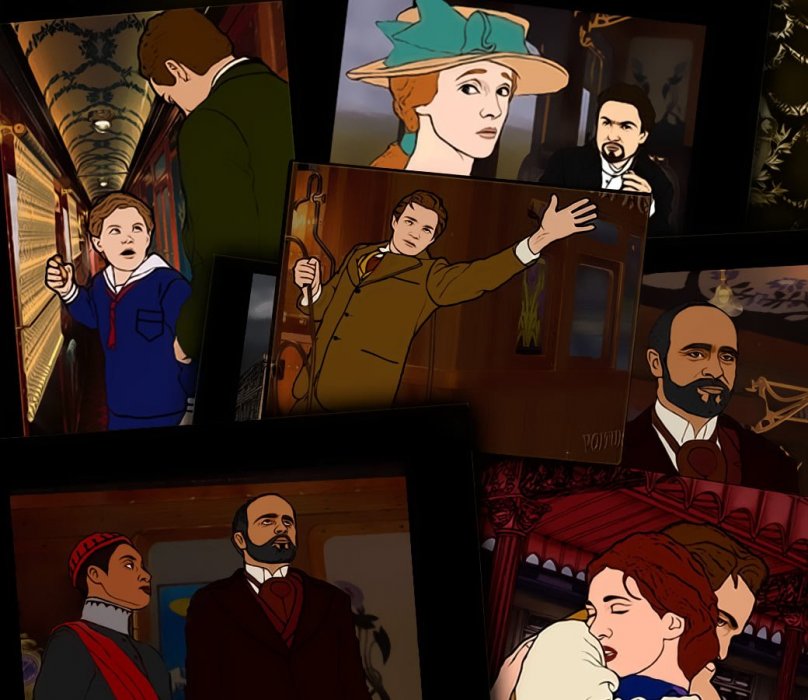RE:Play – The Last Express

This one is a lost gem.
I believe I have made my extremely low opinion of the live-action puzzle games from the 1990s crystal clear. Sure, they made money for their companies, (briefly), but the truth is they were bad. The limitations of green screen studios, plus several hundred-page scripts, combined with the intrinsic problem of multiple dialog trees ensured terrible performances from the actors. And not all of these actors were the result of a community theater casting round-up. Ripper from Take-Two starred Christopher Walken, Karen Allen, John Rhys-Davies, Ossie Davis, Paul Giamatti, and Burgess Meredith. And even these professionals, all turned in abysmal performances. It just was not possible to do a good acting job under these circumstances because the technology itself prevented it.
People can obviously change from one emotional state to another rapidly. But not instantly. The hard cuts imposed by the dialog trees prevented suspension of disbelief. The characters were in one mood in one second and then in a polar opposite mood the next. Emotional engagement with the characters wasn’t possible either because you simply couldn’t buy them as characters.
There have been brain scans conducted on people thinking about real people and then their favorite fictional characters. There was no difference in the scans. Those areas of the brain that were activated by actual humans were the same ones activated by fake people. I guess that is just how the brain works. We haven’t evolved to instinctively understand the difference between real people and very good characters.
But we DO instinctively understand the difference when it comes to BAD characters.
There was no way to take live-action-adventure games to the next level because they were always going to remain what they started out as.
A technical stunt.
That was it, that was all they ever could be with 1990s tech.
Gabriel Knight: The Sins of the Father; was good enough that it rated remastering in 2010. The live action, Gabriel Knight: The Beast Within, absolutely did not.
Which brings up the problem of Gabriel Knight 3.
The market for live-action-adventure ROM games was dying quickly by the late 1990s. Going back to computer animation looked like the way forward but late 1990s PC hardware wasn’t quite up to the challenge yet. The ROM games were able to fill the niche that they did because PC gaming audiences had been trained by their first games to repeatedly swap floppy disks as part of gameplay, so there was no objection to doing this again. And the players wanted their games to reach the next level. Gabriel Knight 3 suffered from computer graphics (and a bad story) that weren’t up to the job yet.
You had the same problem with Titanic: Adventure Out of Time. A decent enough adventure game but the weird things the CG made the actor’s mouths do were just bizarre and off-putting.
Between the failure of live-action and the return of a new and improved generation of computer graphics stepped a quite remarkable game that straddled both worlds. Broderbund’s The Last Express.
It utilized live-action technology but instead of live actors, the game used artwork. It was proper animation. And was easily the best expression of the video game as an art form in the 1990s. The art design was in the Art Noveau school, which was indicative of French art prior to World War One, and very strongly influenced American comic books and animation. It still does so today.
The Last Express takes place on the last run of the Orient Express before the Guns of August sounded. The story follows a valiant American doctor named Robert Cath. Its perspective is first-person but when Cath interacts with other characters, that shifts to third.
Anyway, the opening scene takes place in Paris at the rail station. We hear the announcer over the PA system declare in various languages that the “Orient Express is now departing for…” And we hear the various destinations, while a thin blond man stands at the bottom of a passenger car worriedly scanning the crowd, obviously looking for someone. The train starts to pull out and the man dejectedly goes inside the car. Next, we see the Orient Express chugging along in the French countryside and then a motorcycle with two people on it roars up beside the train. The guy riding bitch, jumps from the bike to the stairs on the passenger car. The biker is a girl who waves happily at the Orient Express’s newest unpaying passenger and takes off. Play begins.
The first person Cath runs into is a young conductor. Cath asks, where Tyler Whitney’s compartment is? Hearing an American accent, the conductor assumes that Cath is Whitney and tells him the compartment number. Upon entering his cabin, Cath discovers to his horror, the brutally murdered body of Tyler. Looks like somebody has a problem and that somebody is you. There has been a murder on the Orient Express.
You are on a train with no ticket and a dead body on your hands.
If you call the conductor, the game fades to a cut scene where an English-girl diarist aboard the train, recounts how a fugitive was arrested for murder. So, not quite getting Sierraed out of the game. But you are still out of the game.
Rewind.
Back to having a dead body to deal with, so you deal with it in the only way possible that doesn’t involve calling the authorities. You chuck your friend’s body out of the window.

…and search the room. There you find a few clues about yourself and why Tyler was killed. Turns out you are both filthy Communists. There is a trunk specially designed to carry a couple of items and those items are missing. You also find out a little bit more about Cath by going through your inventory. He is on the run from the authorities as an accessory in the matter of the murder of a policeman in Belfast.
Even in the 1990s I had some doubts about this guy as a hero.
Regardless, you as Cath set out to solve these two interconnected mysteries, the Murder and the Theft of Something. So, actually, you have three since you don’t know what was stolen.
Three interconnected mysteries.
You head to the parlor car and listen to two women talking about how sexy you are in French. Since you are an American they figure that you won’t be able to figure out what they are saying (it’s usually a good bet).

Cath however, understands quite a few languages. But there are some on this train that he can’t understand. Turkish for one, Serbian for another, and if you know anything about 1914 that is kind of important.
The newspaper in the parlor lets you know that the Assassination of Archduke Ferdinand has happened but that war has not yet been declared yet. If you head into the dining car you get to have a conversation with an arms dealer who thinks you are Tyler and a beautiful violinist who appears to know that you aren’t. Also, she shoots you right out of the saddle, (which is a promising way to start for any romance).
You listen in on conversations that are going on around you and learn about their various dramas. Some of these people, you are going to interact with a lot. Some, you will have nothing to do with. The important thing to know is that this game has a running clock. It’s not exactly a real-time adventure, even though it frequently gets billed as one. However, there are certain actions that you have to execute before a fixed time period runs out. If you fail, you get the fade out to the diarist who chronicles how you got arrested this time or were killed or something else bad. You get the picture. Time to Rewind.
As it is the Orient Express, you have people from all over Europe on the train. Spies, engineers, artists, terrorists, aristocrats, railroad workers, and a mysterious prince in the private car at the rear of the train.

In a lot of ways, this wasn’t so much a game, as it was an interactive movie. Now, believe it or not, I’m actually fine with those provided they aren’t condemning me for, being a White Supremacist. It’s just that most of them do that these days.
The story does its job as a mystery. There are ways to end the story early, but you won’t find out how the story ends that way and that is the final unlock you looking for. You are trying to discover what eventually happens to Cath and his beautiful violinist.
The story is good enough to carry itself, but the artwork is a major draw all by itself.
Smoking Car Productions were quite stringent in their research and focused on their commitment to period accuracy. They didn’t just go off of photos, they actually hunted down existing examples of the Orient Express train cars used in the game. While you didn’t see any live actors proper in the game, there were live actors that were rotoscoped for various set pieces. Mostly, people walking down corridors. Although they were also used in the fight sequences.
Which brings us to the weakest part of the game. The fight sequences. The puzzles were fine. Not particularly complicated and I was happy with that. I didn’t want to be taken out of the story for three damn days trying to figure out how to unlock a jewel box. But the fight sequences are just clunky. There is no real skill at all you just have to click on the right spot at the right moment, or you have to rewind. More irritating than exciting.
One interesting aspect of the story was that it utilized a popular conspiracy theory. That the Germans engineered various events in the summer of 1914 to bring about the guns of August. Arguably, they had reason to do so. The Russian army’s modernization program was progressing a little too smoothly for German liking. if they were to have any hope of winning a double front war they had to have that war sooner rather than later. And they were going to have that war, the French were insisting on it.
Sadly, The Last Express was a box office bomb. It didn’t perform anywhere near expectations. And that was the last nail in Broderbund’s coffin. It left them particularly vulnerable to buyout when they could not defend against it. The company that brought us Prince of Persia, Carmen Sandiego, and Myst was bought up by SoftKey, who then turned around and fired half of the employees, effectively dissolving Broderbund as an organization. It still exists as a label that specializes in education software but it isn’t a patch on the legend it was.
The Last Express is still a great game today, largely because it is not a game, it’s an interactive movie. But as such it holds up quite well. And it’s a pretty cheap but thoroughly enjoyable thrill at five dollars. It’s been ported onto everything modern and it plays on smart pads quite well.
The Dark Herald Recommends with Enthusiasm

